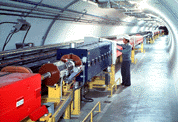

The SPS (Super Proton Synchrotron) tunnel
From 1928 to 1995
1965:antinuclei
By now, all three particles
that make up atoms (electrons, protons and neutrons)
were know to each have an antiparticle. So if particles, bound together
in atoms, are the basic units of matter, it is natural to think that antiparticles,
bound together in antiatoms, are the basic units of antimatter.
But are matter and antimatter exactly equal and opposite, or symmetric, as Dirac had implied? The next important step was to test this symmetry . Physicists wanted to know: how do subatomic antiparticles behave when they come together? Would an antiproton and an antineutron stick together to form an antinucleus, just as protons and neutrons stick together to form an atom's nucleus?
The answer to the antinuclei question was found in 1965 with the observation of the antideuteron, a nucleus of antimatter made out of an antiproton plus an antineutron (while a deuteron, the nucleus of the deuterium atom, is made of a proton plus a neutron). The goal was simultaneously achieved by two teams of physicists, one led by Antonino Zichichi, using the Proton Synchrotron at CERN, and the other led by Leon Lederman, using the Alternating Gradient Synchrotron (AGS) accelerator at the Brookhaven National Laboratory, New York.

